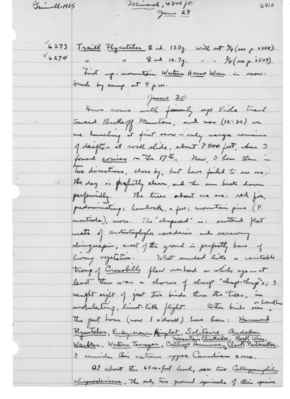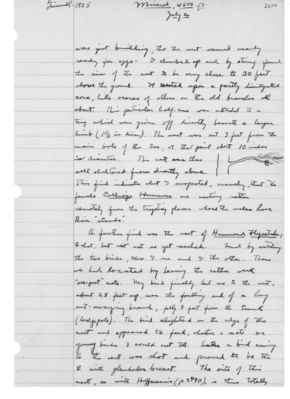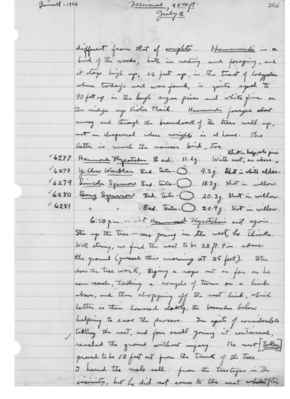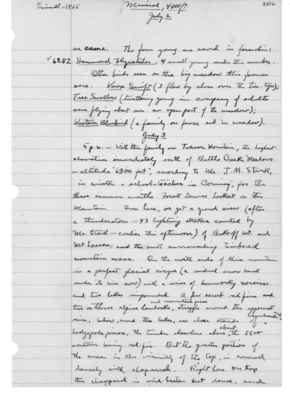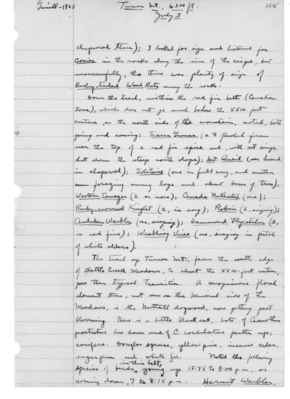Pages That Mention Hammond's Flycatcher
1925: Joseph Grinnell's field notes
S2 Page 57
Collector: Grinnell - 1925 Location: Mineral, 4800 ft. Date: June 29 Page Number: 2510
6273 Traill Flycatcher [female symbol] ad. 13.0 g. with set 3/4 (see p. 2508). 6274 Traill] [Flycatcher] [female symbol] ad. 12.7 g. [with] [set] 3/4 (see p. 2509).
First up - mountain Western House Wren in snow brush by camp at 4 p.m.
June 30 Have come with family up Viola trail towards Brokeoff Mountain, and now (12:30) we are lunching at first snow - only meagre remains of drifts - at rock slide, about 7500 feet, where I found conies on the 17th. Now, I hear them in two directions, close by, but have failed to see one. The day is perfectly clear, and the sun beats down perfervidly. The trees about me are: red fir, predominating; hemlock, a few; mountain pine (P. monticola), more. The "chaparral" is: scattered flat mats of arctostaphylos nevadensis and scrawny chinquapin; most of the ground is perfectly bare of living vegetation. What sounded like a veritable troup of Crossbills flew overhead a while ago - at least there was a chorus of sharp "chup-chup's"; I caught sight of just two birds thru the trees, in undulating, linnet-like flight. Other birds seen ^or heard here the past hour (now 1 o'clock) have been: Hammond Flycatcher, Ruby-crown Kinglet, Solitaire, Audubon Warbler, Western Tanager, Calliope Hummer,^ Mountain Chickadee, Rock Wren, Clark Nutcracker. I consider this extreme upper Canadian zone.
At about 6500-foot level, saw two Callospermophilus chrysodeirus, the only two ground squirrels of this species
S2 Page 61
Collector: Grinnell - 1925 Location: Mineral, 4800 ft. Date: July 2 Page Number: 2514
was just building, tho [sic] the nest seemed nearly ready for eggs. I climbed up and by string found the rim of the nest to be very close to 30 feet above the ground. It rested upon a party disintegrated cone, like scores of others on the old branches all about. This particular half-cone was attached to a twig which was grown off directly beneath a larger limb (1 1/2 in diam.). The nest was out 3 feet from the main bole of the tree, at that point about 10 inches in diameter. The nest was thus [illustration of tree] well sheltered from directly above. [illustration of tree continued] This find indicates what I suspected, namely, that the female Calliope Hummers are nesting rather remotely from the trysting places where the males have their "stands."
A further find was the nest of Hammond Flycatcher; [female symbol] shot, but nest not as yet reached. Found by watching the two birds, Mrs. G. one and I the other. These we had located by hearing the rather weak "see-put" note. My bird finally led me to the nest, about 25 feet up, near the forking end of a long out-swaying branch, fully 8 feet from the trunk (lodgepole). The bird alighted on the edge of the nest appeared to feed, whether a mate or young birds I could not tell. Later a bird coming to the nest was shot and proved to be the [female symbol] with glandular breast. The site of this nest, as with Hoffmann's (p. 2490), is thus totally
S2 Page 62
Collector: Grinnell - 1925 Location: Mineral, 4800 ft. Date: July 2 Page Number: 2515
different from that of wrighti. Hammondi is a bird of the woods, both in nesting and foraging, and it stays high up; 25 feet up, in the tract of lodgepoles where today's nest was found, is quite equal to 90 feet up in the high sugar pines and white firs on the ridge up Viola Trail. Hammondi forages about among and through the branchwork of the trees well up, not in chaparral where wrighti is at home. The latter is much the noisier bird, too.
6277 Hammond Flycatcher [female symbol] ad. 11.2g. With nest, as above. ^Shot in lodgepole pine. 6278 Yellow Warbler [male symbol] ad. testes [testes illustration]. 9.2g. Shot in white alder. 6279 Lincoln Sparrow [male symbol] ad. testes [testes illustration]. 18.3g. Shot in willow. 6280 Song Sparrow [male symbol] ad. testes [testes illustration]. 20.3g. Shot in willow. 6281 [Song] [Sparrow] [male symbol] ad. testes [testes illustration]. 20.4g. Shot in willow.
6:50 p.m. - At Hammond Flycatcher's nest again. Stu up the tree - sees young in the nest, he thinks. With string, we find the nest to be 28 ft. 9 in. above the ground (guessed this morning at 25 feet). Stu does the tree work, tying a rope out as far as he can reach, taking a couple of turns on a limb above, and then chopping off the nest limb, which latter is then lowered slowly, the branches below helping to ease the process. In spite of considerable tilting the nest, and four small young it contained, reached the ground without injury. The nest [taken] proved to be 13 feet out from the trunk of the tree. I heard the male call from the treetops in the vicinity, but he did not come to the nest while after
S2 Page 63
Collector: Grinnell - 1925 Location: Mineral, 4800 ft. Date: July 2 Page Number: 2516
we came. The four young are saved in formalin: 6282 Hammond Flycatcher, 4 small young under this number.
Other birds seen on the big meadow this forenoon were: Vaux Swift (3 flew close over the tree-tops); Tree Swallow (twittering young in company of adults were flying about over the open part of the meadow); Western Bluebird (a family on fence and in meadow).
July 3 5 p.m. - With the family on Turner Mountain, the highest elevation immediately south of Battle Creek Meadows - altitude "6300 feet", according to Mr. J.M. Stark, in winter a school-teacher in Corning, for the three summer months Forest Service Lookout on this Mountain. From here, we get a grand view (after a thunderstorm - 43 lightning strikes counted by Mr. Stark - earlier this afternoon) of Brokeoff Mt. and Mt. Lassen, and the vast surrounding timbered mountain mass. On the north side of this mountain is a perfect glacial cirque (a residual snow bank under its rim now) with a series of hummocky moraines, and two lakes impounded. A few scrub red firs and two or three alpine hemlocks and mountain pines straggle around the uppermost rim; below, around the lakes, are close stands of hemlock and lodgepole pines, the timber elsewhere above about the 5500 contour being red-fir. But the greater portion of the area in the vicinity of the top, is covered densely with chaparral. Right here on top this chaparral is wind-beaten but dense, and
S2 Page 65
Collector: Grinnell - 1925 Location: Turner Mt., 6300 ft. Date: July 3 Page Number: 2518
chaparral there); I looked for sign and listened for Conies in the rocks along the rim of the cirque, but unsuccessfully, tho there was plenty of sign of Bushy-Tailed Wood Rats among the rocks.
Down the trail, within the red fir belt (Canadian Zone), which does not go much below the 5500 foot contour, on the north side of the mountain, noted, both going and coming: Sierra Grouse (a [male symbol] flushed from near the top of a red fir spire and, with set wings, shot down the steep north slope); Mt. Quail (one heard in chaparral); Solitaire (one in full song, and another seen foraging among logs and about bases of trees); Western Tanager (2 or more); Canada Nuthatch (one); Ruby-crowned Kinglet (2, in song); Robin (2, singing); Audubon Warbler (one, singing); Hammond Flycatcher (2, in red firs); Warbling Vireo (one, singing in patch of white alders).
The trail up Turner Mt. from the south edge of Battle Creek Meadows, to about the 5500-foot contour, goes thru [sic] typical transition. A conspicuous floral element there, not seen on the Mineral side of the Meadows, is the Nuttall dogwood, now getting past blooming. There is a little black oak, lots of Ceanothus prostratus low down and of C. cordulatus farther up; conifers: Douglas spruce, yellow pine, incense cedar, sugar pine, and white fir. Noted the following species of birds ^in this belt, going up 12:45 to 3:00 p.m., or coming down, 7 to 8:15 p.m.: Hermit Warbler,
